Home » Hunting Dogs » Weimaraner – Dog Breed Information, Form, Function, History, and More
Weimaraner – Dog Breed Information, Form, Function, History, and More

From their home base in Winnipeg, Craig Koshyk and Lisa…
Weimaraners are a medium to large pointing dog breed that are tireless, cooperative workers and loyal companions with a strong protective instinct.
The story of the Weimaraner has all the elements of a Hollywood melodrama. It is a classic tale of how marketing, money and the vain pursuit of blue ribbons can turn a noble breed of hunting dog into a caricature of its former self. Fortunately, like any good melodrama, there’s a happy ending. Despite the challenges the breed continues to face, there are still dedicated Weimaraner breeders out there producing world-class gundogs.
Listen to more articles on Apple | Spotify
The official history of the Weimaraner begins on June 22, 1897 when a club for the “pure breeding of the silver-grey Weimaraner pointing dog” was formed in Erfurt, Germany. The breed’s development since that time is relatively well documented. The historical record from before that time is much less clear. And since the further back it goes, the fuzzier it gets, all we have are theories based almost entirely on speculation.
Weimaraner Form
The unique look of the Weimaraner is a double-edged sword. Having a hunting dog with a unique color and chiseled good looks is great. I’ve had Weimaraners for over 12 years, and I am still flattered when my hunting buddies tell me my dogs are handsome. But, on the other hand, the look of the breed has captured the attention of huge numbers of non-hunters who now make up the largest market for it. As a result, many breeders select almost exclusively for looks and ignore the most important feature of the breed: its hunting instincts.

Size of the Weimaraner
Weimaraners can be substantial dogs, among the biggest of the Continental breeds. North American field-bred Weimaraners tend to be smaller than their show-bred compatriots.
Males: 23.25-27.5 inches (59-70 cm) and 65-85 pounds
Females: 22.4-26 inches (57-66 cm) and 55-75 pounds
Coat of the Weimaraner
Most Weimaraners have a short, silver-grey coat and cropped tail. Long-haired Weimaraners are identical to the short-haired variety except for having a long, soft topcoat, with or without an undercoat. The long hair lies flat and measures 3 to 5 cm in length. It is somewhat longer on the ears and backs of the legs, and slightly shorter on the head. The tail develops a “plume” of long hair when the dog nears maturity. The tail of the long-haired Weimaraner is usually not cropped.
Long-haired Weimaraners were known to exist for many years before they were officially accepted in 1935, but have always been less common than the short-haired variety. Even today they only represent about 30% of the breed’s population in Germany and Austria; less in other countries. Curiously, the Weimaraner Club of America is the only Weimaraner club in the world to list the long-haired coat as a disqualifying fault. But the disqualification only applies to the show ring, so long-haired Weimaraners may participate in any other event open to pointing dogs.
Another type of coat known as stockhaar is quite rare, and only occurs in dogs that carry both the short-hair and long-hair genes. It is a double coat with a medium-length, flat-lying topcoat, and thick undercoat with a slight amount of feathering sometimes seen on the backs of the legs. Mating a short-haired Weimaraner to a long-haired Weimaraner may produce a stockhaar coat, but it is not a sure bet. The same holds true for two short-haired Weimaraners that carry the recessive long-hair gene. There is only a slight chance that they could produce a stockhaar coat.
The breed’s silver-grey color has always been its most distinctive feature. But a grey coat is not unique to Weimaraners. Pups with grey coats have cropped up from time to time in other breeds. Writing in Weimaraner Heute, Dr. Werner Petri describes seeing grey pups in a litter produced by two black Middle Pinschers, and that prior to the Second World War, grey pups appeared in several litters out of solid brown German Longhaired Pointers. I’ve been told by breeders of GSPs in the Czech Republic and Slovakia that grey pups occasionally occur in their breed and are suspected of being throwbacks to a time when Weimaraners were crossed into GSP lines. A former president of the Cesky Fousek Club, Dr. Jaromir Dostal, has also confirmed that grey pups can also occur in Cesky Fousek litters.
What is unique to the Weimaraner, at least among the pointing breeds, is that breeders specifically select for the silver-grey coat color. According to the breed standard, it is silver, deer or mouse grey, as well as shades of these colors. Genetically, silver-grey is actually a shade of brown that has been altered by a recessive dilution gene. If a Weimaraner is bred to a dog of another breed with a non-diluted coat color, the resulting pups are never grey. They are usually liver or black.
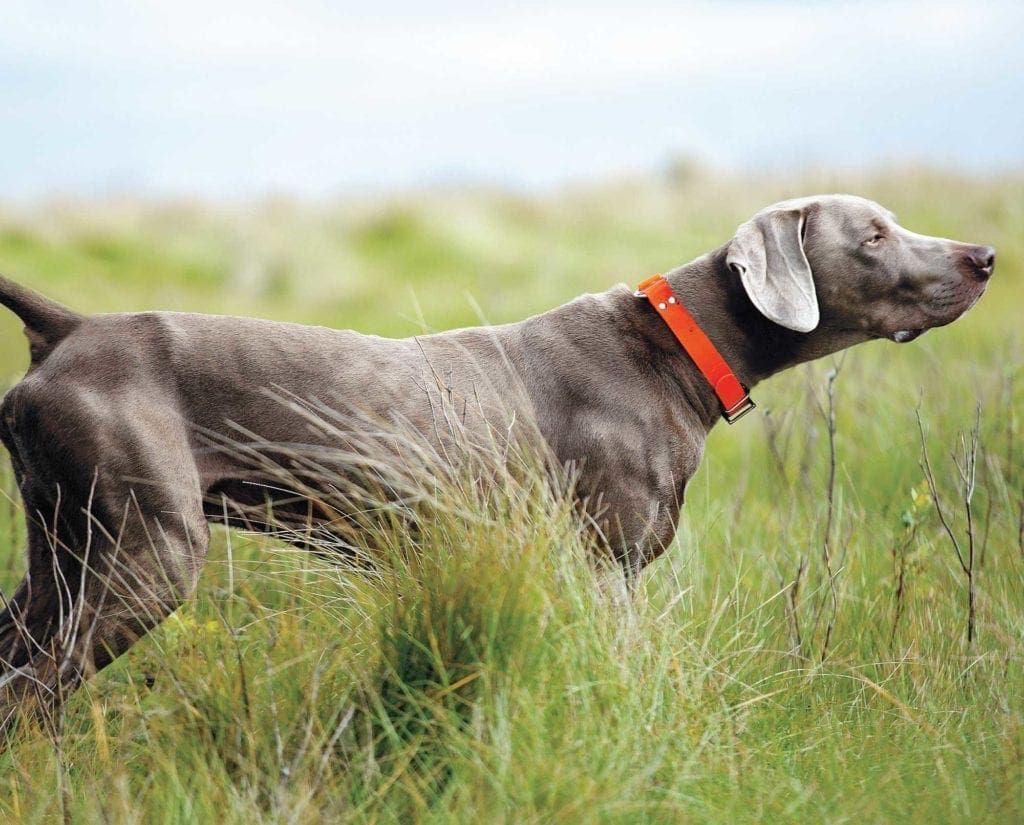
While silver-grey is the only officially recognized color of the Weimaraner, another coat color can occur. The so-called blue Weimaraner has a distinctly blue-grey coat color similar to that of blue Great Danes, Dobermans, or Italian Greyhounds. The color is actually a dilution of black. Blue Weimaraners have black noses and lips, and may have black mottling on the skin inside the mouth. Physically, other than the coat, blues look just like the silver-greys. They have a small but devoted following in the US, and have recently gained some ground in the UK, France and even in Germany, where breeders not affiliated with the parent breed club are now trying to cash in on the “rare” variety.
Unfortunately, blue fanciers are like the grey fanciers—most of them do not hunt! Blues are bred, almost exclusively, as companion animals. Since a blue coat is listed as a disqualification in the show ring, they are not even bred for blue ribbons. Of course, that is not to say that there aren’t any good blues out there; there certainly are. I am aware of several breeders of blues that test their dogs with NAVHDA and have earned respectable scores. Nevertheless, for hunters and field trial enthusiasts, finding a first-rate hunting dog among the blue Weimaraner population usually presents an even greater challenge than finding one among the silver-greys. “Blues” remain a hot-button issue in Weimaraner circles but space does not permit an analysis of all the issues involved.
Weimaraner Character
With such a huge population and so many different lines of Weimaraners out there, it is difficult to describe a “typical” Weimaraner. There is a wide range of personalities in the breed, running the gamut from eager-to-please gundogs to hyperactive basket cases. But if we limit the discussion to dogs with a well-balanced character we can say that, in general, Weimaraners are friendly, extremely intelligent, high-energy dogs. They are not well suited to living in a kennel, and not really the kind of dog that can be left to their own devices around the house. They are often slow to mature, both physically and mentally.
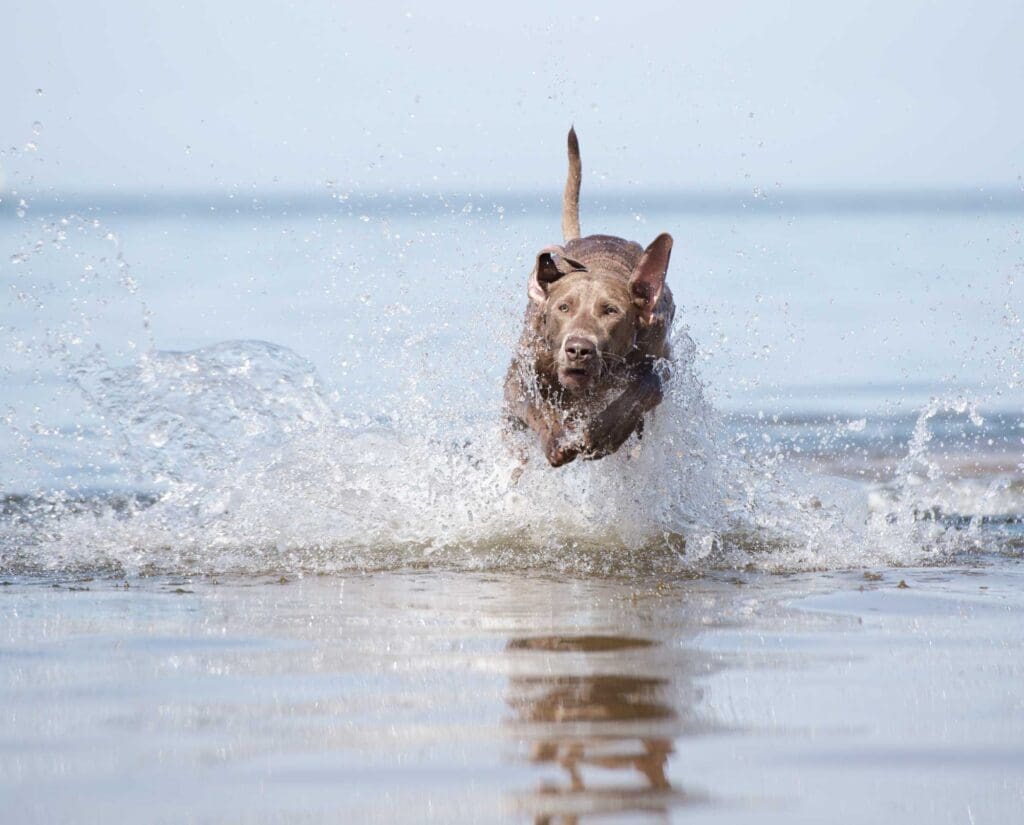
Training of the Weimaraner
The breed is particularly well-known for forming a very strong attachment to its owner/handler. This can be a double-edged sword when it comes to training. The fierce loyalty and tremendous desire to please are great assets but, if not handled properly, they can sometimes lead to dogs that show very little independence. Again, it really depends on what lines they come from and how they are raised. Generally speaking, training a Weimaraner from good, proven stock is fairly straightforward.
Weimaraner and Protection
For over a century, Weimaraner breeders in Germany have sought to breed courageous dogs with a strong protection instinct. Weimaraners are the only pointing breed in Germany required to pass tests designed to evaluate these traits. Tanja Breu-Knaup, a leading breeder of long-haired Weimaraners in Germany, explains that the breed’s reputation of being mannscharf (literally “man-sharp”) is slowly fading:
“In the 1980s, when I first showed up to a training session with my dogs, everyone thought that they would be aggressive. But I proved to them that my dogs are NOT aggressive. Thankfully, things have changed since then.”
Instrumental in the public’s change in attitude has been the decision by the parent club to modify the testing procedure. Steve Graham, an American who has imported Weimaraners from Germany, explains:
“The man-sharpness test (Mannscharfprüfung) was replaced by the new Wesenstest in 2001. In the older test, the handler holds the dog on a lead and the judge, armed with a stick, makes threatening moves toward the handler. The dog is expected to show courage and willingness to defend its handler. In the newer test, the dog must also prove that it is not fearful or aggressive. A group of about a dozen people forms a large circle around the handler and dog. Slowly, the people move toward the center. When the circle is more or less closed, the handler must let go of the leash and exit the circle leaving the dog behind. Once outside of the circle, the handler calls the dog. The dog should then go to the handler. When this is done, the handler and dog re-enter the circle. Judges look for any hint of fear or aggression. If they detect the slightest amount of either, the dog is prohibited from breeding.”
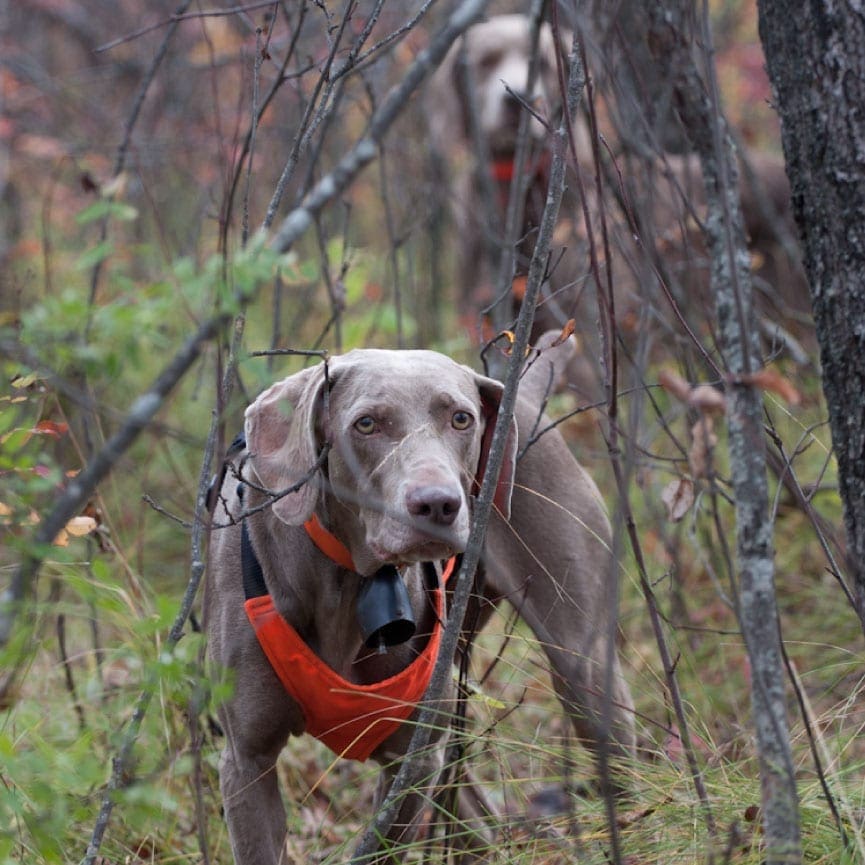
Weimaraner Selection, Breeding, and Populations
Approximately 550 Weimaraner pups are whelped in Germany each year, almost all of them bred by and for hunters. There are probably close to twenty-thousand Weim pups born every year in the rest of the world. Unfortunately, 90% of them are from non-hunting lines.
Field-oriented breeders in North America tend to put more emphasis on speed, range, and point than their German counterparts. Retrieving and water work are also very important for North Americans, but blood tracking and predator sharpness are generally not given much consideration. US and Canadian “field-bred” Weimaraners are often slightly smaller, faster, and may be wider ranging than their relatives from Germany. In terms of appearance, they usually lack the extreme angulation of Weimaraners from show lines.
Aline Curran, an American Weimaraner breeder with US-bred and German-bred dogs, describes the differences between them:
“My German dogs have more drive, more focus. They are bolder, more hard-headed, WAY more intelligent, and did I mention DRIVE? My American dogs from field lines have more style. They are faster and wider ranging, more eager to please, softer, more hyper, and did I mention STYLE? I find the German dogs easier to train, but harder to keep trained. They are very strong-willed and scary-smart. If you don’t stay on top of them, they will find very creative ways of getting away with murder. The Americans, on the other hand, are very eager to please, but don’t catch on as quickly. They are soft, so you can’t rush their training or you will lose the style, which is their best asset. Once they are trained, they stay trained with only gentle reminders.“
While it is reasonable to assume that over the last 100 years the Weimaraner has been bred to fairly high levels of purity, rumors persist that crosses to other breeds have occurred. Only one story can be confirmed. During the 1960s, there was a short-lived and rather divisive program in Germany where a few Weimaraners did in fact receive “outside blood”.
According to a former president of the Weimaraner club, Dr. Werner Petri, a small group of breeders crossed English Pointers and Weimaraners in the early ’60s in an effort to establish a new breed called the Deutsch Halbblut. But the program never really got off the ground, and no dogs from it ever entered established Weimaraner lines.
Several years later, a member of the German Weimaraner club bred one of his Weimaraners to a well-known Pointer bitch. He then bred the offspring to each other. All this was done without the knowledge or permission of the club. When word finally reached the board of directors, they decided, reluctantly, to allow the program to continue under the guise of research into the phenomenon of hybrid vigor. If the offspring were capable of passing all the required tests, then further steps would be taken to blend the crossbred dogs into established Weimaraner lines. In the end, the experiment was declared a failure. The Pointer bitch threw pups with extremely bad bites. That was enough justification for the breed warden to terminate the program. When I asked club members in Germany about those years, one of them said, “That is a chapter in the history of the Weimaraner that is now closed, thank goodness!”
Elsewhere, rumors of crossbreeding continue to make the rounds. In the US, claims and denials of crosses to Pointers and German Shorthaired Pointers have been around for years. In France, knowing winks are exchanged in some circles. The French are rumored to have crossed everything from Pointers to GSPs to Salukis into some lines. However, nothing in either country has ever been proven or publicly declared. What we do know is that in both the US and in France there are still very few Weimaraners capable of winning all-breed field trials. If crosses have been made, they have not had a huge effect overall. Perhaps they were done so long ago that they don’t really matter anymore, or they were not done widely or often enough to change the breed to the same degree that the GSP or Vizsla have been changed.
Health Issues with the Weimaraner
In addition to the health issues faced by other breeds, the Weimaraner seems to be at a somewhat higher risk for autoimmune reactions to certain vaccination protocols. As a precautionary measure, the Weimaraner Club of America recommends that Weimaraner pups receive parvo and distemper shots separately, about two weeks apart. Weimaraners are also reported to be at a higher than average risk for a severe form of hypertrophic osteodystrophy (HOD), an inflammatory condition of the bones and other organs that can be fatal. Other issues of concern are bloat (gastric torsion) and von Willebrand’s disease.
Theories of Weimaraner Origins
While researching the history of the breed for the book, I looked at several of the most common theories and found gaping holes in most of them. The Grey Dogs of King Louis Theory, for example, suggests that Weims descend from dogs known as Chiens Gris (grey dogs) brought back from the orient by King Louis of France hundreds of years ago.
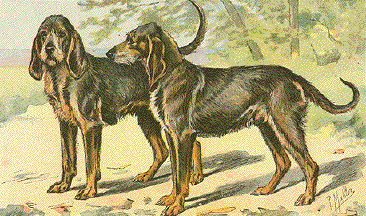
What supporters of this theory conveniently overlook is that the word gris does not refer to the dilute brown shade that gives the Weimaraner its unique color. In the modern standards for the Griffon, Picardy Spaniel, and other breeds, the term gris (and “grey” in the English translation) is used to describe the tight mix of white and brown hairs in their coat. What’s more, the best of King Louis’ dogs were actually said to be tri-colored with gris (brown and white) and/or black along the back and red markings on the legs.
The other commonly held theory is that the breed was created by Grand Duke Charles August of Weimar. However, there is exactly ZERO evidence to support this theory. Personally, I don’t think the Grand Duke had anything to do with the breed at all and I would challenge anyone to provide evidence to support this position. So far no one has taken up the challenge.
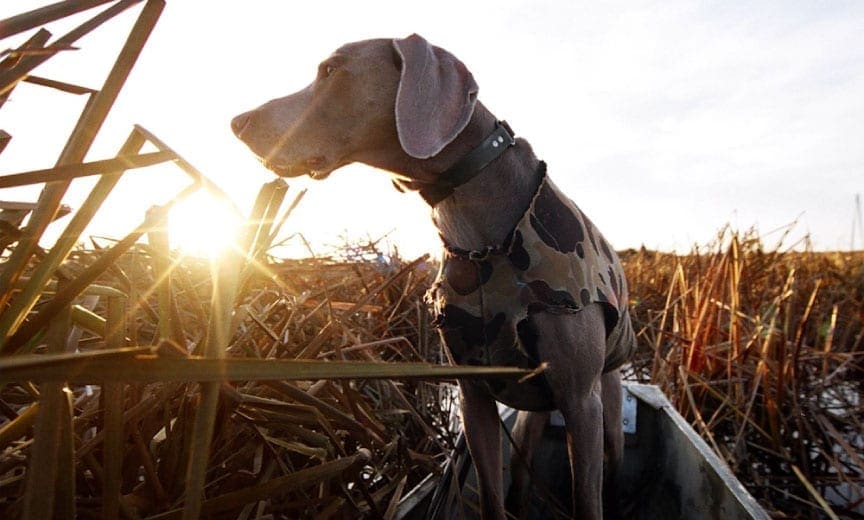
After digging as deep as I could into the history of the breed, I came to the conclusion that the theory that makes the most sense is the GSP Theory. It is one of the more controversial theories and was first proposed around 1900 by several authorities. They claimed that the Weimaraner was either a grey version of the German Shorthaired Pointer (GSP) or that it was created in much the same way as the GSP: by crossing heavy, old-style German dogs with English Pointers.
Karl Brandt, a founding member of the Weimaraner club, supported this theory, as did Dr. A. Stoese, who wrote in 1902 that the Weimaraner descended from a yellow and white smooth-haired English Pointer bitch imported into Germany in the 1820s. Unlike the other theories, the GSP theory is actually supported by some fairly good circumstantial evidence. Several eyewitnesses attest to the fact that the Weimaraner was quickly transformed from a large, lumbering, tracking hound into a sleek pointing dog.
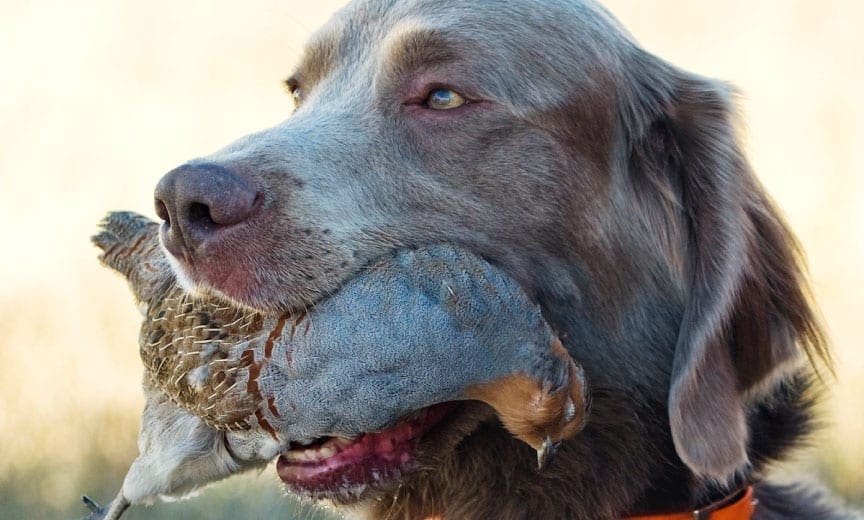
“In my younger years, I saw look like a German bloodhound with hanging lips and watering eyes, but now it has arrived at the form of the German Shorthair and so it has certainly changed for the better.” (Carl Linke quoted by William Denlinger, The Complete Weimaraner, 36)
In the end, it is fair to say that we will never know just how the Weimaraner came to be. But the fact that so much ink was spilled trying to come up with a plausible backstory is very revealing. It shows that breed supporters knew they had to convince the dog establishment that the Weimaraner was not just another recent creation or simply a grey version of the GSP. They had seen how a breed known as the Württemberger was eliminated as an unwanted color variety of the GSP and feared the same thing would happen to the Weimaraner. So they published all kinds of stories about the breed’s supposed noble past and its connections to royal dogs from France.

Major Herber and the German Shorthaired Pointer Stud Book
Breed supporters went on and on about how pure the Weimaraner was and even presented pseudo-scientific “studies” based on crackpot theories of Germanic head shapes and other nonsense. Surprisingly, it worked! After nearly 20 years, the Delegate Commission recognized the Weimaraner as a separate and independent breed. Nevertheless, from 1897 to 1922, Weimaraners did not have their own registry, but were listed in the German Shorthaired Pointer’s stud book. Dr. Werner Petri wrote about the system then in place:
“In the early years, pups were not registered; and only dogs that had previously been shown at exhibitions or tested and evaluated. This was certainly necessary at the time since dogs had to be examined first to establish their “breed purity”, at least when it came to appearance. In the first few years the numbers of Weimaraners entered was from five to 19. In 1900, 62 dogs were registered, obviously en masse, since dogs with birth dates back to 1891 were included. In subsequent years, the entries were sparse, but then, in 1904, a record high of 121 were made. Here again many older dogs born in 1894 are found. Then, the registration numbers fall off strongly once more. From 1907 to 1913 there are no Weimaraners found in the stud book. In total, during the first ten volumes of the Deutsch Kurzhaar stud book, 265 Weimaraners were registered.“
Dr. Petri goes on to explain that the increasing pressure to eliminate the grey coat color from the German Shorthaired Pointer led to some Weimaraners being refused entry into the stud book. As a result, many Weimaraner breeders stopped registering their dogs. This led to a decline in the number of dogs listed and to a decline in the overall population of the breed.
“…it may be assumed that in these years the Weimaraner as a breed was nearing extinction. That was the fate of the Württemberg breed which, by being registered in the German Shorthaired Pointer stud book, went extinct or was absorbed into the German Shorthaired Pointer.“
In the early days, the Weimaraner struggled for survival, coming close to extinction several times. But by the mid-1920s the situation had improved, largely due to the efforts of Major Herber, who first hunted with Weimaraners in 1915 and wrote extensively about them for many years afterwards. He was elected club president in 1922 and ultimately became known as the father of the Weimaraner for his untiring efforts to promote the breed.
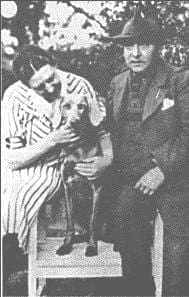
The Second World War and Weimaraner in the United States
The interest generated by Major Herber and others eventually reached across the Atlantic to America, where New England sportsman Howard Knight first heard about the breed in the 1920s. In 1929, Knight became the first non-German to be accepted into the Weimaraner club. He even managed to convince its German members to sell him breeding stock, thus becoming the first person to import Weimaraners to the US. By 1941, he was the president of the newly formed Weimaraner Club of America. Meanwhile, in Germany, Weimaraner breeders suffered the terrible effects of the Second World War. Prior to the conflict, an average of 100 Weimaraner pups were whelped in Germany annually. By 1945, that number had fallen to an all-time low. Club records indicate that in the final year of the war, only ten pups were whelped.
After the war, the few Weimaraner breeders that survived found a willing market for their pups among the hundreds of thousands of foreign servicemen and women occupying their country. Thus, a steady stream of exports began in 1948 and continued throughout much of the 1950s. Eventually, alarmed by the declining quality of the breed and the exodus of good stock to the US and elsewhere, the German club passed a resolution forbidding its members from selling more than half a litter for export. These new regulations, along with a reestablished testing system, soon helped to stabilize the situation in Germany. However, the breed continued to grow rapidly outside the country. The demand for Weimaraners proved to be strongest in the US, thanks mainly to the efforts of publicist Jack Denton Scott, hired by the Weimaraner Club of America to stimulate the market for the “Grey Ghost”.
From Hunting Dog to Sesame Street
James Spencer, in his excellent book POINT! Training the All Seasons Birddog wrote that:
“Mr. Scott and his numerous imitators created the ‘Wonder Dog’ myth, which first lifted the breed to great heights of popularity and then plunged it almost into oblivion in America. Soon after WWII, fast-buck breeders were crawling out of their holes everywhere to hawk Weimaraners. Many made fortunes from the breed. But, of course, the dogs couldn’t perform up to their Wonder Dog billing. What breed could? Gullible Americans realized they had been had. Demand (and prices) fell to near zero. The party was over. The breed was in shambles. To the few serious Weimaraner fanciers, it must have looked like the party site on the morning after a world-class New Year’s Eve bash. First, they had to get the drunks (fast-buck operators) up and out. …Then they had to clean up the mess these ‘guests’ had left.“
The few serious fanciers managed to clean up some of the mess of the early days and by the 1960s some of the damage had been repaired. For hunters, however, the recovery was not without a price. By the 1970s, the Weimaraner was quickly becoming yet another breed of gundog transformed from hunter of game to hunter of blue ribbons. If it were not for a small, dedicated group of field trialers and hunters, Weimaraners could have faded completely from the field, forest, and waters of North America.
Then, in the 1990s, the breed was dealt another blow as a new generation of fast-buck operators rediscovered the lucrative market for grey dogs. And once again it was largely due to one man—this time, a photographer named William Wegman—that the breed captured the imagination of the general public. But instead of touting it as a wonder dog for hunters, Wegman’s work portrays Weimaraners as cute dress-up dolls and even part of Sesame Street. The artist made a fortune flogging all manner of kitsch featuring photos of his Weimaraners dressed in humiliating costumes, and the market for the Grey Ghost became red-hot again as tens of thousands of Weimaraner pups were bred and sold. Inevitably, many were dumped into rescue shelters (or worse) as new owners realized that a rapidly growing adolescent Weimaraner is anything but a cuddly dress-up doll.
For Wegman and the eager breeders riding his coattails, it was a gold rush. For the Grey Ghost, it was yet another disaster.

The Weimaraner’s Current State
First, the bad news: most Weimaraner breeders do not hunt. Most Weimaraner breeders do not participate in field trials or prove their dogs’ ability in hunt tests. Most Weimaraner breeders focus their efforts on servicing a massive and growing market of non-hunters seeking sleek grey dogs for companionship or showmanship. As a result, for every decent, hard-hunting Weimaraner in the world today, there are at least 100 others that range from mediocre to completely useless in the field.
As a lover of the breed, it pains me to admit such things and I expect to receive some hate mail for doing so, but I would be less than honest if I did not point out the fact that most Weimaraners being bred today are not really hunting dogs. They may be great pets, beautiful blue ribbon champions, and loving members of the family, but the hunting heritage of most lines has been neglected for so many generations that dogs from them no longer have enough natural ability to do a decent day’s work in the field.
Now, the good news: A great hunting Weimaraner is not that hard to find! The comparatively small number of breeders that continue to hunt and test or trial their Weims produce dogs that can hold their own against any other breed of Continental pointing dog in the world. Ninety-nine percent of the Weimaraners born in Germany, for example, are from proven, tested stock.
Outside of Germany, the largest group of field-oriented breeders is in the US where dedicated individuals have made tremendous progress in the last 30 years. They produce top-notch hunting dogs, even a few that are competitive in all-breed field trials. There has also been a significant increase in the number of Weimaraners being tested in NAVHDA and, while only a few of them have earned the title of Versatile Champion, that number will surely increase as a new generation of NAVHDA-oriented breeders develops more lines based on fully tested dogs. Other areas showing progress in producing good hunting stock are France, Holland, Sweden, Denmark, and Norway.

Weimaraner Tests and Trials
The Weimaraner club of Germany follows a testing and breeding program similar to other JGHV-affiliated clubs. It sanctions VJP, HZP and VGP events, as well as various tracking tests. In Germany, Weimaraners must pass at least the first two levels of tests (VJP, HZP), as well as a coat, conformation and character examination, in order to be certified for breeding. The Austrian and the Czech clubs run similar tests, although they use a slightly different scoring system.
In the US, there is a fairly active AKC field trial scene for the breed. The Weimaraner Club of America and its affiliates organize 20 to 30 trials every year, including a National Championship held near Ardmore, Oklahoma. Several kennels have been very successful in the field trial arena and have done an outstanding job of keeping the hunt in their lines, while working toward developing class bird dogs for all-breed competition. The WCA also holds field-oriented ratings tests. Dogs can earn titles for upland bird work and/or retrieving. There is a small but growing number of Weimaraners participating in the NAVHDA testing system, with several kennels now using it to select their breeding stock.
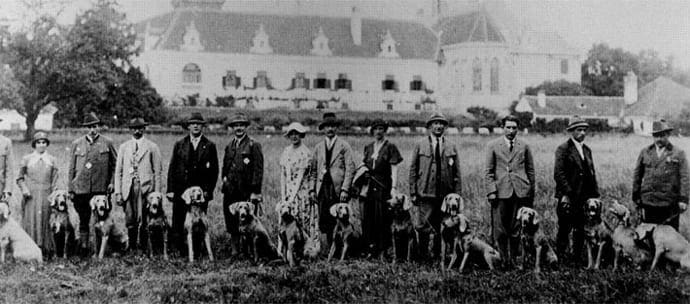
In the UK, France, Italy, Holland, Denmark, Sweden, Norway and Finland, Weimaraners can occasionally be seen in field trials and hunt tests. Like their American counterparts, European Weimaraner enthusiasts outside of Germany, Austria, and the Czech Republic tend to place more emphasis on the breed’s upland bird hunting abilities than on big game hunting or blood trailing.
Function of the Weimaraner
Field Search
I have seen Weimaraners that were ultra- close workers, hunting at a fairly methodical pace. I have also seen one or two that ran for the horizon like bats out of hell. However, most Weimaraners have a close to medium range and hunt at a medium gallop. Judy Balog, a leading American Weimaraner breeder, says, “Good Weims can search a field as well as any other versatile breed. But even the widest-ranging Weimaraners are not run-offs. They keep a sharp eye on their owners and willingly hunt for the gun while handling kindly.”
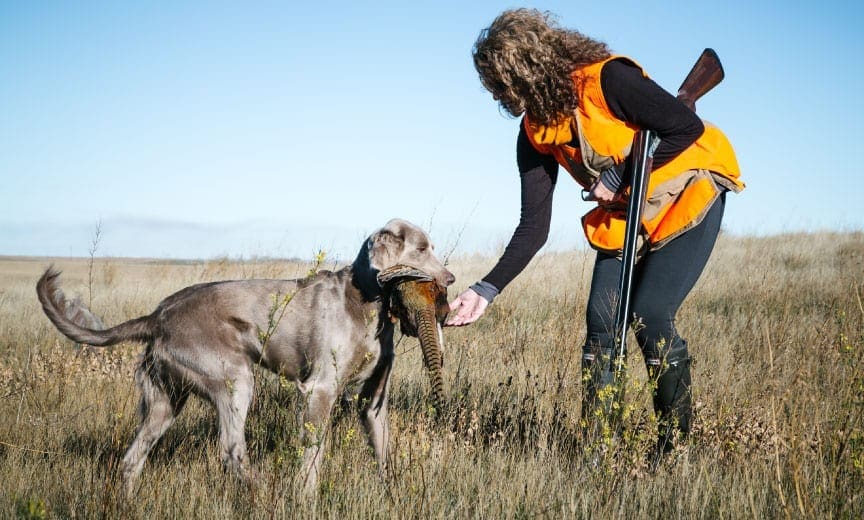
Pointing
The pointing instinct can be slow to develop in some Weimaraners. Once they mature, however, they are generally strong pointers. Those selected for field trials in the US and Europe tend to have a very strong pointing instinct that develops earlier. Americans, in particular, place more emphasis on style of point, and look for dogs that display a higher head and tail. Like most other Continental breeds, natural backing is occasionally seen, but it is not particularly common.
Retrieving
Most Weimaraners are natural-born retrievers that show a strong desire to fetch anything and everything at a very early age. The retrieving instinct may, in fact, be one of the most deeply seated traits of the breed. Even in lines where the run and point have almost been completely bred out, the desire to retrieve often remains quite strong.
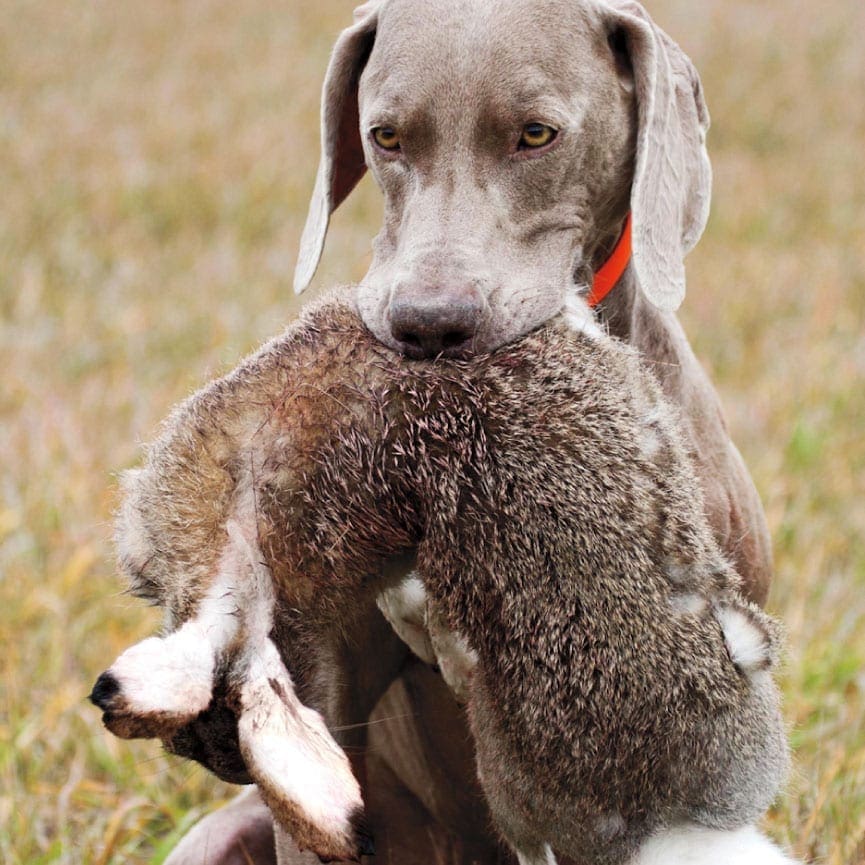
Tracking
Perhaps because of its Leithund heritage, the Weimaraner has always been known for a “deep nose”. In Germany, a lot of emphasis is placed on selecting and testing for tracking ability. A lower head is greatly valued. So is giving voice on track, a behavior called spurlaut. In America, many breeders prefer a higher head, but do not ignore tracking ability completely as it is an important aspect of upland game hunting and NAVHDA testing. However, there is very little emphasis placed on big game tracking among Weimaraner fanciers outside of Germany and Eastern Europe. Nor is there any attempt to select for traits such as spurlaut.
Water Work
Weimaraners can be excellent water workers. Some may need more encouragement than others when first being introduced to water, but once they have learned to swim, they can be top-notch performers. The short-haired version of the breed may not be the best choice for the late-season waterfowler. Even the long-haired variety, which is better able to work in cooler temperatures, may not be well suited to breaking ice in deep waters.
Judy Balog says, “The young Weim may need a little more early encouragement, but once they mature I think they’re hard to beat and most make top-notch water retrievers.”
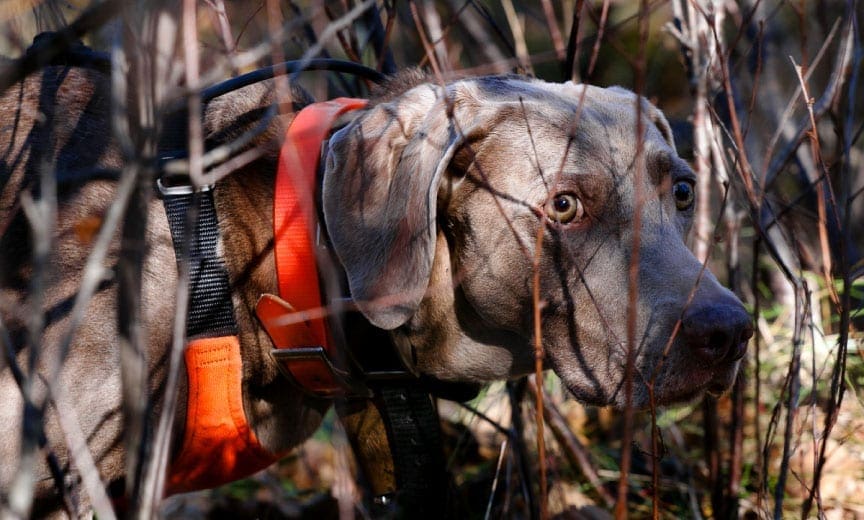
Craig’s Take on the Weimaraner
The Weimaraner is not the only breed dominated by non-hunting breeders and owners. And, to be fair, some Weimaraner breeders do select for “dual” dogs capable of winning in the field and the show ring. But the fact remains: the majority of Weimaraners in the world today are not bred to hunt. Anyone seeking one as a hunting partner needs to keep this in mind. If you deal only with breeders who actually hunt and/or prove their dogs in tests and trials, you stand a very good chance of getting a great Weim.
If you don’t, then all bets are off.
From their home base in Winnipeg, Craig Koshyk and Lisa Trottier travel all over hunting everything from snipe, woodcock to grouse, geese and pheasants. In the 1990s they began a quest to research, photograph, and hunt over all of the pointing breeds from continental Europe and published Pointing Dogs, Volume One: The Continentals. The follow-up to the first volume, Pointing Dogs, Volume Two, the British and Irish Breeds, is slated for release in 2020.




I really enjoyed this article. It gave me the best history of the breed that I have read. Gives me a lot more understanding of my wiem and what to expect from him. Thanks. Tommy
Thanks. Interesting reading. I have owned Weimaraners for the past 41 years. I no longer hunt, but my blue-grey Sophia is a smart runner and loves accompanying me on bike rides ranging from 6-13km. As companion she is excellent. Strong -willed and proud, but very smart in the obedience class. As therapy dog, the training shows that she will improve with maturity. For now she’s just so much fun. She does hunt with a passion. Wild pigeons and some two months ago even ran in a Haneda, before take-off.
The WCA Vaccine protocol is misquoted sadly.
Thank you for pointing this out. The new protocol approved by the Weimaraner Club of America Board of Directors on December 5, 2020 can be found here: https://www.weimaranerclubofamerica.org/puppy_protocol.php
I will try to update the link in the article so that goes to the page with the updated information.
Back in about 1950 my uncle Keith Larson imported some weimers and did breeding for a while. as a kid I got a runt from him but of course it soon was not a runt and he took it back. Wish I had been able to hunt with on.
Great article Craig and spot on with most of what you say. I remember a few years ago now you put up something similar in FB and it ruffled a few feathers (pardon the pun) especially here in Australia. I knew Werner Petrie quite well and he was a great source of information to both I and Rosemary on the breed. We imported a dog from GERMANY many years ago and agree with what Aline Curran said about the German breed dogs as it certainly applied to Salto our import. Thankfully there are some of us over here still trying to get that balance of working ability while still trying to maintain good conformation but is hard going to get it right
Great read. My first Wiem, my best hunting companion as well as couch potato.https://photos.app.goo.gl/K5d9Df2KKtjtzEUj6
Great Article! I am currently running a Great Weimar. Took a little more effort to pull the prey drive out but now have a competing gun dog that is a great companion. I hope this is not offending to you that he is not pure bred but wanted to run a unique pup.
Is the Weimaraner breed being exploited for profit by unethical breeders, leading to an increase in health issues and a decline in population numbers?